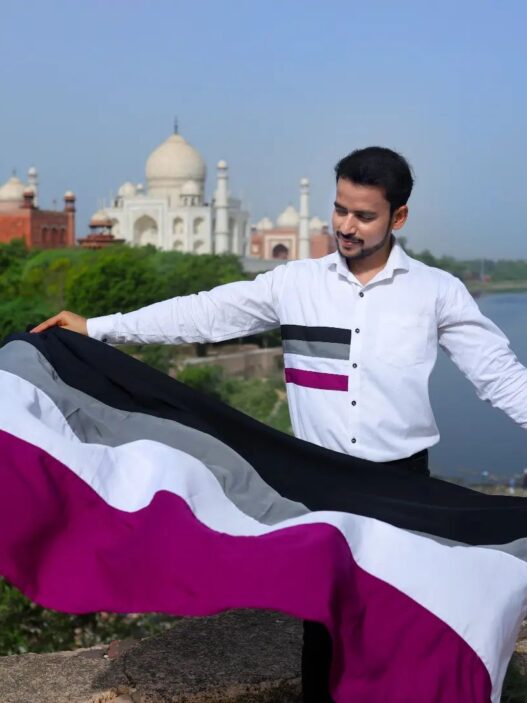A Theoretical Framework
The ANOAQA moderator’s primary responsibility is to ensure the immediate physical and emotional safety of the caller. All interactions should be guided by a risk assessment mindset, maintaining vigilance for signs of imminent harm or danger.
Issue 1: High Libido Without Sexual Attraction
STEP 1: Psychoeducation
Explain to the client that libido (sexual desire) and sexual attraction are separate phenomena. Normalize their experience and reassure them that it is valid.
STEP 2: Emotional Validation
Allow space for clients to express feelings of alienation, confusion, or shame without judgment. Validate the distress caused by social expectations.
STEP 3: Identity Exploration
Support the client in exploring labels like asexual, greysexual, or others (if they are interested) to create self-understanding and empowerment.
STEP 4: Stress Management Techniques
Teach grounding exercises, breathing techniques, mindfulness, and body-awareness exercises to manage distress from libido.
STEP 5: Pleasure Redefinition
Help them redefine pleasure (non-sexual forms of joy like hobbies, art, nature, friendships) to stimulate happiness beyond sexual realms.
STEP 6: Building a Support Network
Assist the client in identifying affirming friends, communities (online/offline), or support groups.
STEP 7: Long-term Emotional Regulation Plan
Co-create a daily and weekly routine for managing libido healthily (through exercise, creativity, safe solo practices if applicable) and maintaining emotional resilience.
Issue 2: Peer Pressure and Fear of Loneliness
STEP 1: Normalize the Fear
Acknowledge that fear of loneliness and aging is natural but not a personal failure.
STEP 2: Challenge Internalized Beliefs
Use cognitive restructuring to question harmful social narratives: “Am I really ‘less’ without a partner?”
STEP 3: Develop Assertiveness Skills
Teach techniques to handle peer pressure (e.g., boundary setting, practicing responses to invasive questions).
STEP 4: Create Meaningful Social Connections
Identify ways to form deep friendships, platonic partnerships, and communal living options.
STEP 5: Future Planning
Help clients envision positive futures where they age with dignity, chosen family, and community.
STEP 6: Introduce Narrative Therapy
Support the client in rewriting their life story where their identity and choices are celebrated.
STEP 7: Suicidality Screening and Crisis Planning
Regularly screen for suicidal thoughts. Establish safety plans and emergency contacts if necessary.
Issue 3: Social Invisibility and Queer Housing Discrimination
STEP 1: Acknowledge and Validate
Affirm that systemic discrimination is real and unjust; the problem is social, not personal.
STEP 2: Safety Assessment
Help the client assess and plan for immediate personal safety if experiencing threats.
STEP 3: Empower Legal Literacy
Provide basic education about tenant rights, women’s rights, and available legal aid resources.
STEP 4: Build Self-Advocacy Skills
Role-play conversations for negotiating with landlords or asserting tenancy rights confidently.
STEP 5: Supportive Community Search
Encourage connection with feminist, asexual, or single women’s networks for housing referrals or shared living spaces.
STEP 6: Crisis Coping Plans
Develop action plans for high-risk periods (e.g., if evicted or harassed).
STEP 7: Ongoing Therapy for Trauma Processing
Offer longer-term trauma-informed therapy to address feelings of helplessness, despair, and suicidal ideation.
Issue 4: Forced Marriage and Mental Health Trauma
STEP 1: Crisis Intervention (If Needed)
Immediately assess safety. If client is still at risk, refer to shelter services, legal help.
STEP 2: Validation of Trauma
Acknowledge forced marriage as a violation of human rights, not a ‘cultural norm’ to accept.
STEP 3: Psychoeducation on Trauma Responses
Explain symptoms (hypervigilance, dissociation, flashbacks) to reduce confusion and self-blame.
STEP 4: Processing the Trauma
Use trauma therapies like EMDR (Eye Movement Desensitization and Reprocessing), somatic experiencing, or talk therapy.
STEP 5: Safety and Boundary Setting
Support the client in establishing physical, emotional, and legal boundaries from abusive family members.
STEP 6: Grief Work
Address grief over lost autonomy, time, and family betrayal.
STEP 7: Long-Term Empowerment Plan
Help the client set long-term goals (education, independence, meaningful relationships) as a survivor reclaiming their life.
Issue 5: Marital Rape and Psychological Distress
STEP 1: Immediate Safety and Risk Assessment
Determine if the client is in ongoing danger. Prioritize shelter, protection, or emergency intervention if necessary.
STEP 2: Validation without Pressure
Believe the client. Reassure them that marital rape is real and a violation regardless of marriage status.
STEP 3: Psychoeducation on Consent and Rights
Educate gently about bodily autonomy, consent, and possible legal protections (adapt to local laws cautiously).
STEP 4: Therapeutic Processing of Assault
Apply trauma-informed approaches focusing on regaining bodily autonomy and emotional security.
STEP 5: Empowering Decision-Making
Support the client’s choices whether they want to stay, separate, or seek legal action—without pushing.
STEP 6: Building Coping Mechanisms
Introduce somatic grounding, emotion regulation, crisis management techniques for daily stability.
STEP 7: Integrative Healing Plan
Create a holistic healing plan involving body work (yoga, dance, art therapy), social reintegration, and long-term empowerment goals.
“For: A-Spec, Single Women, Survivors of Forced Marriage, and Related Groups in Bangladesh
Purpose: To equip new psychologists with clear, empathetic, trauma-informed steps.
Common Structure for All 5 Issues (Applied Flexibly)
Step 1: Establish Trust and Safety
- Begin by creating a warm, non-judgmental space.
- Normalize the client’s feelings (e.g., “Many people have similar experiences, you are not alone”).
- Ensure confidentiality, and discuss clear session boundaries.
Step 2: Psychoeducation
- Explain relevant concepts gently:
- Libido vs Sexual Attraction (for Issue 1).
- Impact of peer pressure, social norms, and loneliness (Issue 2).
- How discrimination operates systemically (Issue 3).
- Coercion and trauma in forced marriage (Issue 4).
- Dynamics of marital rape and trauma (Issue 5).
- Emphasize that their feelings are valid and their pain has psychological reasons, not personal “weakness.”
Step 3: Emotional Validation and Grieving Space
- Allow the client to express sadness, anger, confusion without interruption.
- Introduce the concept of “ambiguous grief” (grieving the life they hoped for but were denied).
- Recognize losses (e.g., safety, choice, dignity, social visibility).
Step 4: Coping Skill Building
Teach coping skills appropriate to their issue, such as:
- For Issue 1 (High libido without attraction): Grounding exercises, body neutrality practices, exploring hobbies that bring physical joy (sports, dance, gardening).
- For Issue 2 (Loneliness, peer pressure): Building small, authentic communities, practicing assertive communication (“I choose this for myself” scripts).
- For Issue 3 (Queer Housing discrimination): Safety planning, seeking women’s cooperatives, connecting with activist groups.
- For Issue 4 and 5 (Forced marriage, marital rape): Trauma grounding, crisis planning, developing escape strategies if needed, seeking NGO legal aid contacts.
Step 5: Monitoring, Relapse Prevention, and Crisis Management
Schedule follow-ups, even if informally through text or calls (where culturally acceptable).”
Regularly assess for depression, anxiety, and suicidality.
Create a Crisis Plan:
Warning signs
Emergency contacts
Self-soothing activities
Asian Network of A-Spec Queer Activists
Specific Notes for Common Issues
| Issue | Additional Focus |
| 1. High Libido Without Attraction | Normalize that sexual feeling does not mandate action. Differentiate libido from romantic compulsion. Encourage body autonomy. |
| 2. Peer Pressure & Loneliness | Deep grief work around societal alienation. Reframe solitude as strength, not failure. Explore safe solo living options. |
| 3. Social Invisibility & Housing Discrimination | Empower with legal knowledge where possible. Safety-first housing strategies. Document discrimination if safe. |
| 4. Forced Marriage Trauma | Trauma recovery models (like Judith Herman’s 3 stages: Safety → Remembrance → Reconnection). Advocate non-contact strategies with abusers if needed. |
| 5. Marital Rape Distress | Validate the reality of marital rape (often denied in law and culture). Empower bodily autonomy. Connect to legal or feminist support where possible. |
Essential Rules for Helpline Moderators:
1. Document sessions carefully,
2.Respecting client confidentiality and consent.
Always work at the client’s pace.
Practice cultural sensitivity but never compromise human rights.
Maintain ongoing suicide risk assessments throughout therapy.
Refer to legal aid, shelters, crisis centers as needed.
Core Reminder:
- Every caller is the expert of their own life.
- Our role is to listen, affirm, and open the doors they choose to walk through.











[…] economics and politics forms a complex and intricate web that shapes the world we live in. The Economics-Politics Nexus refers to the symbiotic relationship between economic policies and political decisions, […]
[…] economics and politics forms a complex and intricate web that shapes the world we live in. The Economics-Politics Nexus refers to the symbiotic relationship between economic policies and political decisions, […]
[…] economics and politics forms a complex and intricate web that shapes the world we live in. The Economics-Politics Nexus refers to the symbiotic relationship between economic policies and political decisions, […]
I\’m impressed by your writing style and the depth of your knowledge on this topic.
I\’m glad you enjoyed it! Your kind words inspire me to keep creating informative content.
Your post is a true masterpiece. I\’ll be referencing it in my own work.